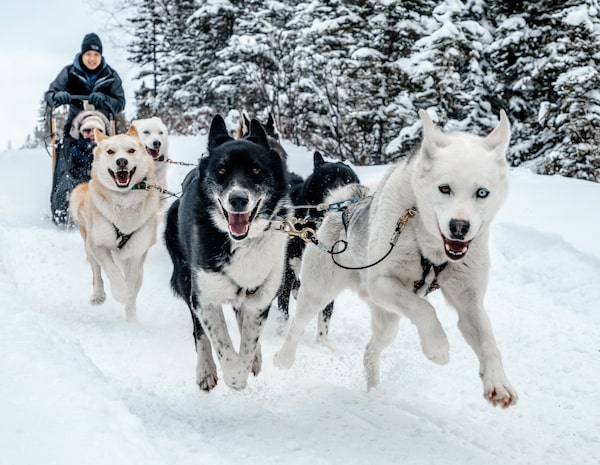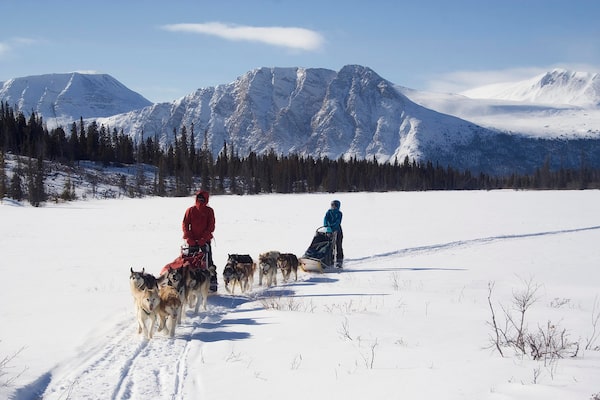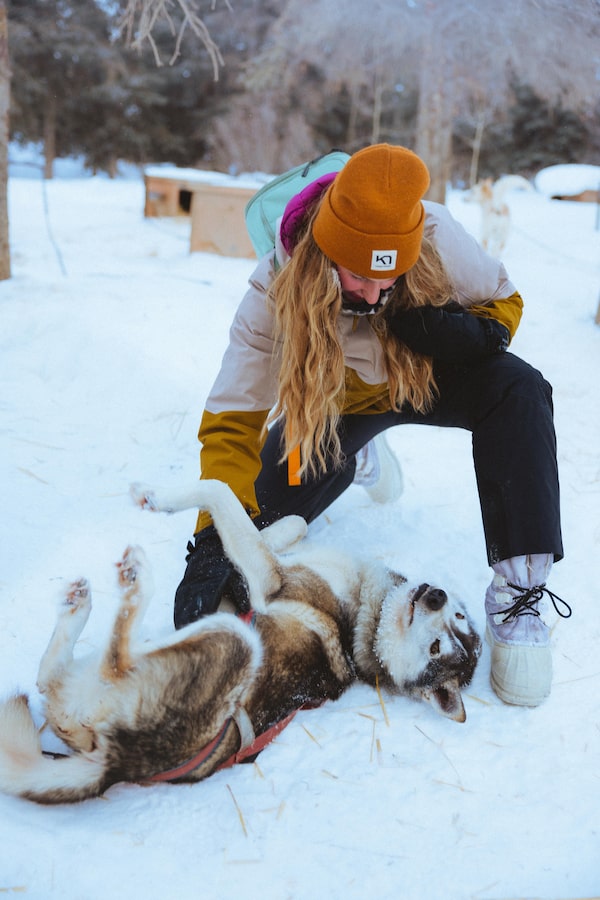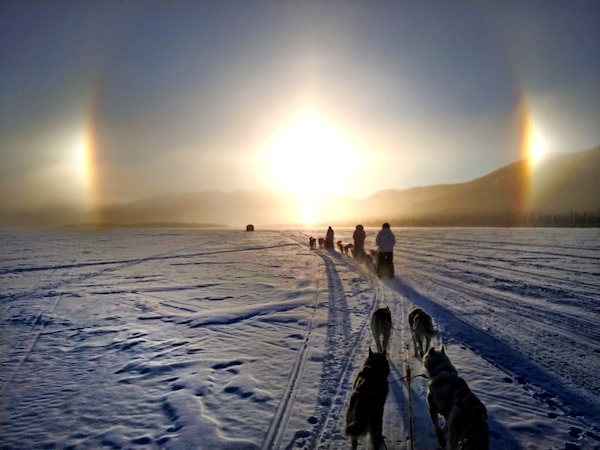
Snowy Owl Dog Sled Tours offers one- and two-person sleds until mid-April, weather permitting.The Globe and Mail
Jereme Asenault loves his huskies – all 180 of them – and he’d really like his guests to be dog lovers, too.
OK, it’s a pretty much a prerequisite.
Asenault owns one of Canada’s top dog sled tour operations, Snowy Owl Sled Dog Tours. His parents founded the company in Canmore, Alta., in 1983, and he’s worked in the business practically his entire life.
Asenault says his dogs “immediately love every client,” and will pull anyone,any time, “because that’s what they’re bred to do; it’s what they want to do more than anything in the world.”
But Asenault wants to know that feeling is mutual before handing over command of one of his dog sleds to a visitor.
“Dog sledding is about a relationship-based mutual respect,” he says.
Sled drivers don’t just stand there, like in the movies. You help propel the sled by peddling with one foot, like skateboarding. It’s a total workout.
— Jocelyne LeBlanc, co-owner of Sky High Wilderness Ranch
Before a guest is taught mushing (or sled-driving) basics – “Gee! Haw!” (Go right! Go left!) – they learn that they will meet and greet each member of their team of four to six dogs and that each dog loves positive reinforcement from their musher, like encouraging words, pets and hugs.
Snowy Owl Sled Dog Tours offers winter sled tours until around mid-April that can last anywhere from two hours ($472.50 for a one-person sled) to a two-day, winter-camping expedition. Guests dine on filet mignon as the Aurora Borealis shimmers in the sky and stay cozy in a heated tent when it’s below zero outside.
During the overnight trip, participants take in “so many amazing vistas,” says Asenault. “It’s an unreal experience but most people will tell me, the best part of the whole trip is connecting with the dogs. I love hearing that.
”You can just sit back and relax at the campsite, he says – “or you can learn to make the dogs’ food, feed them, set up their straw beds, put them down for the night and harness them for the run.”
Most campers go all in because, “looking after the dogs is a large part of the tour,” he says.
Born to run
With their thick coats, incredible strength and stamina, huskies can go for miles pulling sleds through snow.
Anthropologists suggest sled dogs helped humans migrate from Siberia to North America and were crucial to human survival in the arctic.
”Sled dogs helped our ancestors hunt more efficiently; they could set more traps,” says Garrick Schmidt, who is Metis and owner of Eagle Ridge Dog Sled Tours, near Moose Mountain Provincial Park, in Saskatchewan.

Sky High Wilderness Ranch is located within the breathtaking mountain and valley setting of Fish Lake, near Whitehorse, Yukon.The Globe and Mail
Sled dogs are now mostly bred to race (Alaska’s Iditarod and the Yukon Quest, both 1,600 kilometres, are the world’s most famous races) and for recreation, says Schmidt.
Eagle Ridge offers 10-kilometre tours, during which participants learn about the traditional aspects of mushing.
Schmidt shares the legend of the wolf, who gifted his pups to humans and showed ways to harness and utilize them for transportation. The wolf-dogs loved pulling humans – just like Schmidt’s dogs do.
“They get really excited to see the harness,” exclaims Schmidt. “Once you see how happy the dogs are, you will fall in love with [sledding] and having that connection with the dogs.”
Learning Indigenous stories and participating in traditional ways of living is one way to take part in reconciliation, says Schmidt. “It’s about understanding our culture.
”The Canadian Tourism Commission lauds dogsled tours in its Signature Experiences Collection, which spotlights one-of-a-kind encounters throughout the country. Tourists can hire kid-friendly, afternoon sled-dog excursions in Labrador, Quebec and Ontario, while multiday mushing trips are more common in western Canada.
Near Whitehorse, Yukon, an off-the-grid lodge is the base for a two-week dogsledding adventure – a time span that allows clients to experience the “magical” partnership with a dog team that grows while navigating incredibly remote wilderness, says Jocelyne LeBlanc.
A Yukon Quest veteran, LeBlanc co-owns Sky High Wilderness Ranch, located in the breathtaking mountain-valley setting of Fish Lake. With no electricity, piped-in water or cellular service, guests “disconnect from modern life,” says Leblanc and “build trust with their dogs” during a few daylong dog sled trips – before leaving for tent camping. Tours can operate into early spring, weather permitting.
Traversing the serene and pristine white landscape, guests feel a surge of new life in their soul, says LaBlanc. “They’re like, ‘wow, I got to relax my brain.’”
Dog sled workout
At the same time, dog sledding is an athletic sport and “participants must be fit,” insists LaBlanc.
“Sled drivers don’t just stand there, like in the movies,” she explains. “You never let your dogs pull you up hills – although they happily would – you run with them.” In tough terrain, “you help propel the sled by peddling with one foot, like skateboarding.” Even staying balanced requires strong, core muscles, she adds. “It’s a total workout.”
By the end of two weeks, many guests have connected so strongly with their dogs, that leaving them becomes the toughest part of the entire expedition.
“When people cry, that means that they bonded,” says LaBlanc. “To me, that’s the best part of everything I do.”

Clients get to know their sled dogs before heading out on an adventure at Sky High Wilderness Ranch.The Globe and Mail
Careful vetting key to adoption program for retired sled dogs
Snowy Owl Sled Dog Tour’s Jereme Arsenault would rather keep every one of his 19 huskies currently retired from pulling sleds. “But my wife has limits. I’m only allowed five dogs in the house at one time.”
So, his “dog-first company and advocate for animal welfare,” also runs a dog adoption program.
Sled dogs are purpose-bred to run and pull, which means they thrive when working, says Arsenault. But another key breeding trait is friendly disposition.
“They’re more than working dogs, they’re working pets,” says the musher.
Between the ages of eight or nine, however, “we want to see our beloved husky heroes hang up their harness,” and enjoy retirement for another seven, or more, years. “It’s a nice life balance,” says Arsenault.
Retired sled dogs easily transition to house-pet life, he adds. “They’re much smarter than puppies.”
Potential adopters are carefully vetted in a lengthy, no-cost process that includes a minimum of 10 visits with the dog at Snowy Owl’s Canmore, Alta.-based kennel.
It’s about finding the best match for both the dog and the person adopting.
Descriptions of adoptable huskies are lovingly detailed on Snowy Owl’s website. Almond, a shy, pure white husky, “can be nervous about new experiences but he’s working on being brave!”
Meanwhile, athletic Burlap is “like a furry rocket ship,” says Arsenalt. “So, I can’t give him to somebody who lives in an apartment.” He should live where there’s lots of outdoor space, preferably with a jogger, he says.
“We want the second chapter of his life to be a super-happy, fun, positive experience.”

Traversing the serene and pristine white landscape, guests feel a surge of new life in their soul, says Sky High Wilderness Ranch co-owner Jocelyne LaBlanc.The Globe and Mail